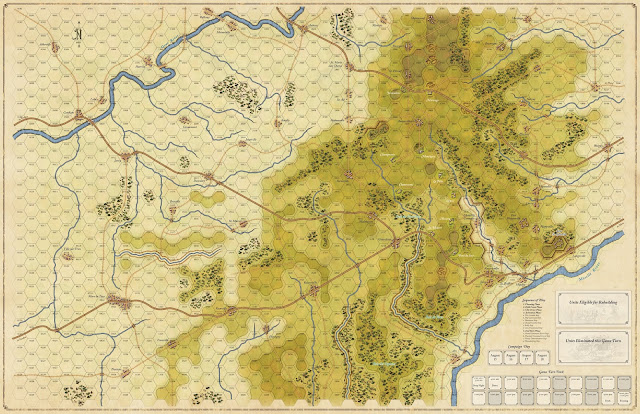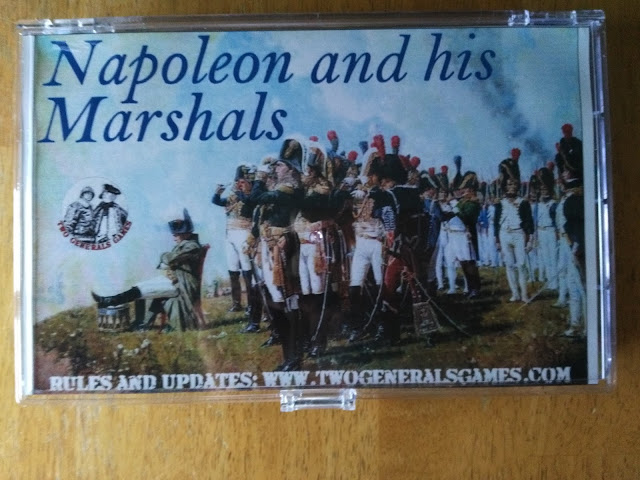THE WAR OF THE WORLDS
Two previous games had focused on the geography of the novel keeping setting in the limited environs of London and the south-east of England as a more or less conventional hex-based war game. DVG have gone for a broad-brush strategy approach featuring the whole of the UK [and. as you'll see, potentially further!].
The all-embracing conception of the art complements the theme perfectly. Though Wells focuses the events in his novel on a small portion of southern England, we can see it as a microcosm for the whole world. It certainly allows for this core game [The War of The Worlds: England] to span the whole of the United Kingdom and enterprisingly beyond to other editions subtitled East Coast America, France and Japan! An option, called League of Terran Nations, is offered at the end of the rule book, which allows you to play multiple nations simultaneously. Though I know that I'll never aspire to this challenge, it is a nice extra.
Three Handling machine counters begin the game on the map; one in Scotland, one in Wales and one in Leicester. Leicester? Very strangely the substantial Zones [that cover several counties] in England are named after various cities. Next, Wave 1 of the Tripods is randomly placed according to a die roll [and that Zone's Production marker is replaced by a Devastation marker] - none of the possible locations are anywhere near where Wells' chose for them to land in his novel. In fact the most likely arrival spot is Scotland. Again, game mechanics designed to give you, the Human player, a chance of victory overcome the facts of the source novel. The final item to roll for is the placement of the first Cylinder which will ultimately produce a subsequent Wave of Tripods.
I mention such points, as they have led to a range of uncertainties and questions. Nothing major, but these small points do add up and an especial warning if, like me, you often look online to BBG [Boardgamegeek] for useful playthrough/how to play videos. Though only 3 months old the video provided by Kevin and Dan Verssen contains many significant differences in the rules from what's there in the published game!
Having survived [or not] any Battles, you move straight on to the Devastation Phase where - surprise, surprise - a die roll is made in every Zone where there's a Wave marker. This quickly and very abstractly will determine a variety of losses, including some or all of the following: 1 or 2 Human VPs, 1 Human unit and upto 5 Workforce, as well as creating a number of Refugees. The next Phase, Human Action, will pass just as quickly. All Human units/Characters can move one Zone and Infantry instead of moving can roll either to see if they destroy a Tripod that hasn't yet emerged from a Cylinder or to place a Powder Keg.
The Escape Phase promises exactly what it says. Any Refugees currently in a Zone with a Harbour roll to attempt to escape. The first roll determines whether they are successful in fleeing with a two thirds chance of success. Otherwise they stay put in the Zone, but if you think that having successfully fled the danger's over, it's not! All it means is that you've successfully boarded a freighter to take you to safety.Now you roll again - 50% chance of making a clean get away, but if not you'll have to fight your way to safety against either one or two Tripods on the Naval Board.
A Naval Battle has similarities to a Land Battle, though frankly is more enjoyable as you have to manoeuvre your freighters - and possibly a Warship or two if you can afford to buy them - from the top of the board to the bottom. Meanwhile the Tripod is governed by the same card drawing and die rolling process as in a Land Battle to randomly move and fire on your ships. It's enjoyable, but seems a rather prolonged process in order for you to gain usually at best one or two VPs or for the Martians to gain one or two VPs.
Rather oddly it's at the end of this Phase that you tot up how many VPs you've earned this turn, one point for every Refugee escaped and 1 point for every Production site not devastated. As you start the game with 10 out of your 11 Production sites operable, that's a 10 VP start at the end of the first turn. 10 VPs turn into 1 Germ and 10 Germs win you the game - so, a simple bit of maths and it's 100 VPs for a win. [Spoiler alert - avoid next paragraph, if you haven't read Wells' novel, The War of The Worlds, and you want to do so before playing the game].
Why Germs? Well, as a nod to the novel - the plucky British don't triumph against all odds, a deus ex machina, good old Mother Nature does the job - germs kill off the Martians! So, let's turn VPs into germs and then if you win, hey presto, you can say the germs got them - though in game terms, it's escaping Refugees, killing Tripods and mainly having undevastated production Zones giving you VPs each turn that brings you out victorious.
So, back to our game. Only two swift Phases left. First the Martian Action Phase, which is far less dramatic than it sounds. Another simple die roll for each Zone that contains a Martian Wave marker. The possible results are as follows: the Wave moves to a different Zone [that's right roll the die to find out which one], the Wave gains an extra Tripod or part of the Flying Machine is built. There is usually a one in six chance of the latter happening and if all four parts of the Flying Machine get built the Human player loses the game. This single detail has so far been the most criticised aspect of the game, as a series of early bad rolls and you are toast. In my most recent game, I was doing very nicely on 84 VPs, the Narrator's Wife had safely escaped [a nice thematic touch] with the Martians trailing on 54 VPs, when the fourth part of the Flying machine was built. Game over.
The last task in this Phase is to roll for each Zone that has a Destroyed marker to see if it turns into a Red Weed Zone and add up Martian VPs. 2VPs for each destroyed Zone and 4 VPs for each Red Weed Zone. Like the Human player, 10 VPs are turned into a Colonisation Point and 10 Colonisation points mean that the Human has lost.
The final Phase is the Assembly. In every Zone where there is a Martian Handling machine and a Cylinder, roll the die and if the colour matches the colour of the Handling Machine, the Cylinder is replaced by the next numbered Wave marker.
The only other feature to mention is the deck of Event cards. I really like how this is handled, as the deck is made up of Events labelled for every Phase of the turn, but the top card is only played when it matches the current Phase. So, at least one Event card will definitely be played each turn, but the earlier the Phase that this happens the more likely it is that you will get the next card matching a later Phase in the turn and so on. Some turns I've had a single Event card playable, at others up to four and once five!
So, final conclusions. A fairly swift and easy game with some minor uncertainties in the rules that have largely been cleared up on BGG, but as yet no definitive Errata/FAQ published. Components are excellent and greatly add to the flavour of the game. A light game that depends heavily on dice rolling which brings in an equally heavy slice of luck. For me, it's not so much the luck element as the lack of major choices on the player's part that makes me want more control. That said, there are often many micro-moments of decision that add to the already frequent tension generated by so many of the die rolls, especially as the game moves into its later stages. DVG are obviously looking to widen their appeal and I think this game has a potential to hit the lighter end of the market, but for my own tastes I prefer their typical meatier historical war games.
Once again many thanks to DVG for supplying the review copy.
Standard Price
$59.99
£55.99
And my next review up will certainly cover a very heavy weight grognard's historical war game on three battles of the Crimean war!
So, look out for Bloody Steppes of the Crimea in a few weeks' time.
































Follow Us